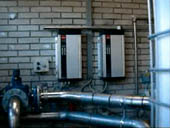Case Study 2
Manual of the Future


| Goal | To create a set of long-term visions for how a manual for an industrial motor controller would look in 5-10 years. |
| Deliverables |
|
| Process |
In order to create compelling, plausible visions we started the
process by visiting customers and trying to understand the environment that they
work in, and how they use the product manual.
We video taped the field studies and customer workshops in order to provide
convincing evidence for our design ideas.
The field studies not only kept our design ideas relevant to the customers but were the source of ideas to improve the manual. |
Sample Results
Example 1
Customers spoke about tactile things like "pumps", "torque" and "speed", while the manual and product interface used abstract terms like "motors", "current" and "frequency". A design opportunity was identified that the manual could be clearer if it spoke the language of the customers. From the field studies we learned that the product manuals were also used to design systems with motors, so a specific design idea was to include "recipes" describing how motor controllers were used in various real-world contexts.
Example 2
From the field studies we knew that a major use of the manuals was to look up the error codes that appear on the product interface. (e.g. "Alarm 12") Our gut-reaction was to replace the cryptic codes on the interface with the more informative messages in the manual. However, we found that the resellers of the product often had to support their customers, and if they were diagnosing a problem over the phone, an error code was better than a verbose message (especially when dealing with foreign customers). When re-designing the future product interface, we kept the numerical error codes while we added a detailled explanation for the code.
![Pronounced [Zin-site] Xinsight logo](/images/xinsight_reveal_dark.gif)





